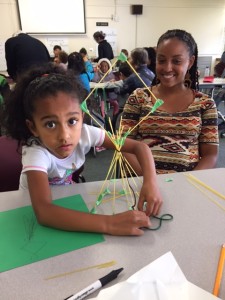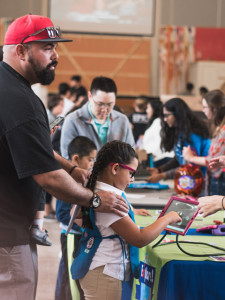Libraries Reduce the Opportunity Gap
By Linda Kekelis
What do libraries have to do with STEM (science, technology, engineering, and math)? These days, plenty. You can find preschoolers and their caregivers engaging in hands-on science and math activities, girls and mothers tinkering with tools and technology, and families learning to code at summer lunch programs all at their local public library. These experiences spark new interests in kids, build confidence in parents, and can even have lasting impact on career interests.
What makes these library programs so important is how they help reduce the opportunity gap in STEM. While not every community has a science center, tech museum, or zoo, just about every town has a library that offers books along with access to computers and STEM programs for families. Libraries bring resources and fuel dreams that help reach underserved and underrepresented people and regions.
STEM Next Opportunity Fund wants all families to have access to quality STEM programs. Over the past two years we’ve been listening and learning from families and educators across the country to better understand how STEM programs can be more inclusive. Equity and access are essential considerations guiding our work. You can read what we’ve learned along with research, promising practices, and case studies in our white paper, Changing the Game in STEM with Family Engagement: A White Paper for Practitioners and Field Leaders to Empower Families in STEM.
I’ve personally seen the power of family engagement in libraries and gained an appreciation of the challenges and opportunities in making these STEM programs accessible to families who are sometimes left out. Here are four strategies to help inspire and deepen engagement with families at libraries.
 #1 Be humble and be aspirational. Invite parents and caregivers to the table as you plan new programs and evaluate existing programs for families. Listen and learn from parents—especially those who haven’t yet come to your library—to understand what they want and need and what might be barriers to their participation. The Waukegan Public Library in Illinois enlisted ambassadors—or promotoras—to reach out to Latino families who hadn’t yet visited the library. These trusted community members are trained to visit homes and talk with Latino families. They help families understand the opportunities that libraries have to offer and help library staff develop programs to meet their needs.
#1 Be humble and be aspirational. Invite parents and caregivers to the table as you plan new programs and evaluate existing programs for families. Listen and learn from parents—especially those who haven’t yet come to your library—to understand what they want and need and what might be barriers to their participation. The Waukegan Public Library in Illinois enlisted ambassadors—or promotoras—to reach out to Latino families who hadn’t yet visited the library. These trusted community members are trained to visit homes and talk with Latino families. They help families understand the opportunities that libraries have to offer and help library staff develop programs to meet their needs.
#2 Be creative in helping families continue STEM learning at home. Offer resources so that families can repeat an activity, connect with a role model, or find online classes to take their learning to the next level. There are lots of STEM resources online and programs in the community; the sheer number can be overwhelming. Scientific Adventures for Girls includes in every program a hand-out that summarizes the day’s activity with science explanations as well as a worksheet for participants to jot down ideas, hypotheses, and observations. Additionally, the hand-out provides thought-provoking questions encouraging families to extend the projects at home. Related website links and books (available at the library) are included in these take-home sheets. Scientific Adventures for Girls staff also invite library partners to display STEM books for families to check out.
 #3 Be intentional to include youth with disabilities and their parents. Youth with disabilities are often on the sidelines when it comes to STEM activities in school and in out-of-school programs. Don’t let the lack of opportunities or stereotypes hold them back from their potential in STEM. Find partners who can help you create library programs that welcome youth with disabilities and their families. Support staff in building their skills and confidence in adapting STEM activities. Learn from Deaf Kids Code and Techbridge Girls on how to create STEM experiences for youth who are disabled that teach skills and change attitudes. Youth are inspired and more confident and parents see new possibilities for their child.
#3 Be intentional to include youth with disabilities and their parents. Youth with disabilities are often on the sidelines when it comes to STEM activities in school and in out-of-school programs. Don’t let the lack of opportunities or stereotypes hold them back from their potential in STEM. Find partners who can help you create library programs that welcome youth with disabilities and their families. Support staff in building their skills and confidence in adapting STEM activities. Learn from Deaf Kids Code and Techbridge Girls on how to create STEM experiences for youth who are disabled that teach skills and change attitudes. Youth are inspired and more confident and parents see new possibilities for their child.
#4 Reduce the gender gap in STEM. While girls start out curious and confident, some girls lose interest and confidence in STEM. Consider offering programs where girls can discover their inner engineer and code with confidence. Sunnyvale Public Library created Make-HER, a program for girls ages 8-12 and their mothers (or significant female). Strong female role models lead fun projects with programmable wearable technology and optical illusion toys and show the creative and collaborative possibilities for STEM. The magic of Make-HER is how it empowers two generations. Seeing their mothers becoming more confident and competent may help explain the increase in confidence that the mothers see in their daughters. I love how Make-HER shares its projects online.
We encourage you to select one of these strategies and commit to implementing it in the coming year at your library. Share your discoveries and lessons learned with familyengagement@stemnext.org. For more ideas, check out our resources to support family engagement in STEM.
On behalf of STEM Next, I commend the STAR Library Education Network’s efforts around family engagement. The Network’s STEM resources and professional development for librarians are helping to reduce the opportunity gap in STEM by empowering parents and caregivers.
Linda Kekelis, PhD, is an advisor for STEM Next Opportunity Fund. Family engagement has been a passion for Linda and at the center of the research and programs she has led for over two decades. lkekelis@gmail.com @LindaKekelis




Leave A Comment